An alternative stress boundary condition in small deformations and its application to soft elastic composites and structures
IF 3.4
3区 工程技术
Q1 MECHANICS
International Journal of Solids and Structures
Pub Date : 2024-09-30
DOI:10.1016/j.ijsolstr.2024.113088
引用次数: 0
Abstract
Linear elasticity theory has been used extensively in the study of the elastic behavior of various perforated structures and composite materials requiring the accompaniment of appropriate boundary conditions to derive qualitatively correct and quantitatively referential solutions. When incorporating conventional boundary conditions, however, linear elasticity theory fails to predict certain essential phenomena associated with perforate structures and composite materials even when they undergo small deformations. For example, a soft elastic porous medium is appreciably stiffened when inflated despite the fact that the internal air pressure is significantly lower than the modulus of the medium itself. In this paper, we propose an improved stress boundary condition by simply incorporating a small change in the normal to the boundary during deformation. We show via numerical examples that in the context of linear elasticity theory, the use of this improved boundary condition offers the possibility of predicting the influence of initial or residual stress in a perforated structure on the elastic response of the structure to external loadings (which can never be captured with the use of conventional boundary conditions). We perform also large-deformation-based finite element simulations to verify the accuracy of the closed-form results obtained from the improved boundary condition for a soft elastic perforated structure with initial internal pressure. We believe that the idea presented in this paper will extend the applicability of linear elasticity theory and yield more accurate referential analytic results for soft elastic structures and composites.
小变形中的另一种应力边界条件及其在软弹性复合材料和结构中的应用
线性弹性理论被广泛应用于研究各种穿孔结构和复合材料的弹性行为,需要适当的边界条件来得出定性正确和定量参考的解决方案。然而,在结合传统边界条件时,线性弹性理论无法预测与穿孔结构和复合材料相关的某些基本现象,即使它们发生微小变形时也是如此。例如,软弹性多孔介质在充气时会明显变硬,尽管内部气压明显低于介质本身的模量。在本文中,我们提出了一种改进的应力边界条件,只需在变形过程中加入边界法线的微小变化即可。我们通过数值示例表明,在线性弹性理论的背景下,使用这种改进的边界条件可以预测穿孔结构中的初始应力或残余应力对结构对外部载荷的弹性响应的影响(使用传统边界条件永远无法捕捉到这种影响)。我们还进行了基于大变形的有限元模拟,以验证改进边界条件对具有初始内压的软弹性穿孔结构的闭式结果的准确性。我们相信,本文提出的想法将扩展线性弹性理论的适用范围,并为软弹性结构和复合材料提供更精确的参考解析结果。
本文章由计算机程序翻译,如有差异,请以英文原文为准。
求助全文
约1分钟内获得全文
求助全文
来源期刊
CiteScore
6.70
自引率
8.30%
发文量
405
审稿时长
70 days
期刊介绍:
The International Journal of Solids and Structures has as its objective the publication and dissemination of original research in Mechanics of Solids and Structures as a field of Applied Science and Engineering. It fosters thus the exchange of ideas among workers in different parts of the world and also among workers who emphasize different aspects of the foundations and applications of the field.
Standing as it does at the cross-roads of Materials Science, Life Sciences, Mathematics, Physics and Engineering Design, the Mechanics of Solids and Structures is experiencing considerable growth as a result of recent technological advances. The Journal, by providing an international medium of communication, is encouraging this growth and is encompassing all aspects of the field from the more classical problems of structural analysis to mechanics of solids continually interacting with other media and including fracture, flow, wave propagation, heat transfer, thermal effects in solids, optimum design methods, model analysis, structural topology and numerical techniques. Interest extends to both inorganic and organic solids and structures.

 求助内容:
求助内容: 应助结果提醒方式:
应助结果提醒方式:


